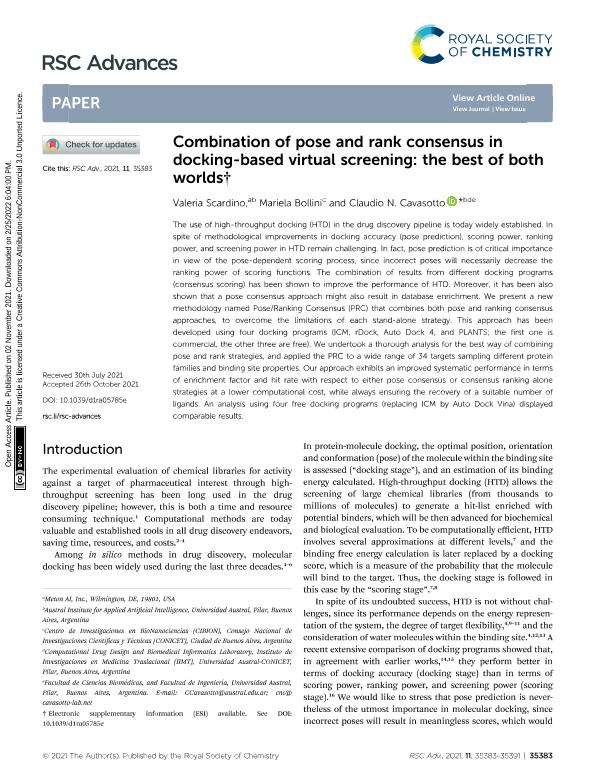Mostrar el registro sencillo del ítem
dc.contributor.author
Scardino, Valeria
dc.contributor.author
Bollini, Mariela

dc.contributor.author
Cavasotto, Claudio Norberto

dc.date.available
2022-10-14T11:24:48Z
dc.date.issued
2021-10
dc.identifier.citation
Scardino, Valeria; Bollini, Mariela; Cavasotto, Claudio Norberto; Combination of pose and rank consensus in docking-based virtual screening: The best of both worlds; Royal Society of Chemistry; RSC Advances; 11; 56; 10-2021; 35383-35391
dc.identifier.issn
2046-2069
dc.identifier.uri
http://hdl.handle.net/11336/173147
dc.description.abstract
The use of high-throughput docking (HTD) in the drug discovery pipeline is today widely established. In spite of methodological improvements in docking accuracy (pose prediction), scoring power, ranking power, and screening power in HTD remain challenging. In fact, pose prediction is of critical importance in view of the pose-dependent scoring process, since incorrect poses will necessarily decrease the ranking power of scoring functions. The combination of results from different docking programs (consensus scoring) has been shown to improve the performance of HTD. Moreover, it has been also shown that a pose consensus approach might also result in database enrichment. We present a new methodology named Pose/Ranking Consensus (PRC) that combines both pose and ranking consensus approaches, to overcome the limitations of each stand-alone strategy. This approach has been developed using four docking programs (ICM, rDock, Auto Dock 4, and PLANTS; the first one is commercial, the other three are free). We undertook a thorough analysis for the best way of combining pose and rank strategies, and applied the PRC to a wide range of 34 targets sampling different protein families and binding site properties. Our approach exhibits an improved systematic performance in terms of enrichment factor and hit rate with respect to either pose consensus or consensus ranking alone strategies at a lower computational cost, while always ensuring the recovery of a suitable number of ligands. An analysis using four free docking programs (replacing ICM by Auto Dock Vina) displayed comparable results.
dc.format
application/pdf
dc.language.iso
eng
dc.publisher
Royal Society of Chemistry

dc.rights
info:eu-repo/semantics/openAccess
dc.rights.uri
https://creativecommons.org/licenses/by-nc/2.5/ar/
dc.subject
pose and rank consensus
dc.subject
virttual screening
dc.subject.classification
Otras Ciencias Químicas

dc.subject.classification
Ciencias Químicas

dc.subject.classification
CIENCIAS NATURALES Y EXACTAS

dc.title
Combination of pose and rank consensus in docking-based virtual screening: The best of both worlds
dc.type
info:eu-repo/semantics/article
dc.type
info:ar-repo/semantics/artículo
dc.type
info:eu-repo/semantics/publishedVersion
dc.date.updated
2022-08-23T20:50:01Z
dc.journal.volume
11
dc.journal.number
56
dc.journal.pagination
35383-35391
dc.journal.pais
Reino Unido

dc.description.fil
Fil: Scardino, Valeria. Universidad Austral; Argentina
dc.description.fil
Fil: Bollini, Mariela. Consejo Nacional de Investigaciones Científicas y Técnicas. Oficina de Coordinación Administrativa Parque Centenario. Centro de Investigaciones en Bionanociencias "Elizabeth Jares Erijman"; Argentina
dc.description.fil
Fil: Cavasotto, Claudio Norberto. Universidad Austral. Facultad de Ciencias Biomédicas. Instituto de Investigaciones en Medicina Traslacional. Consejo Nacional de Investigaciones Científicas y Técnicas. Oficina de Coordinación Administrativa Parque Centenario. Instituto de Investigaciones en Medicina Traslacional; Argentina
dc.journal.title
RSC Advances
dc.relation.alternativeid
info:eu-repo/semantics/altIdentifier/doi/http://dx.doi.org/10.1039/d1ra05785e
Archivos asociados
